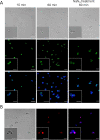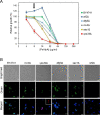Novel findings about the mode of action of the antifungal protein PeAfpA against Saccharomyces cerevisiae
- PMID: 37688596
- PMCID: PMC10589166
- DOI: 10.1007/s00253-023-12749-0
Novel findings about the mode of action of the antifungal protein PeAfpA against Saccharomyces cerevisiae
Abstract
Antifungal proteins (AFPs) from filamentous fungi offer the potential to control fungal infections that threaten human health and food safety. AFPs exhibit broad antifungal spectra against harmful fungi, but limited knowledge of their killing mechanism hinders their potential applicability. PeAfpA from Penicillium expansum shows strong antifungal potency against plant and human fungal pathogens and stands above other AFPs for being active against the yeast Saccharomyces cerevisiae. We took advantage of this and used a model laboratory strain of S. cerevisiae to gain insight into the mode of action of PeAfpA by combining (i) transcriptional profiling, (ii) PeAfpA sensitivity analyses of deletion mutants available in the S. cerevisiae genomic deletion collection and (iii) cell biology studies using confocal microscopy. Results highlighted and confirmed the role of the yeast cell wall (CW) in the interaction with PeAfpA, which can be internalized through both energy-dependent and independent mechanisms. The combined results also suggest an active role of the CW integrity (CWI) pathway and the cAMP-PKA signalling in the PeAfpA killing mechanism. Besides, our studies revealed the involvement of phosphatidylinositol metabolism and the participation of ROX3, which codes for the subunit 19 of the RNA polymerase II mediator complex, in the yeast defence strategy. In conclusion, our study provides clues about both the killing mechanism of PeAfpA and the fungus defence strategies against the protein, suggesting also targets for the development of new antifungals. KEY POINTS: • PeAfpA is a cell-penetrating protein with inhibitory activity against S. cerevisiae. • The CW integrity (CWI) pathway is a key player in the PeAfpA killing mechanism. • Phosphatidylinositol metabolism and ROX3 are involved in the yeast defence strategy.
Keywords: Antifungal proteins (AFPs); Cell wall integrity; Cell-penetrating protein; Phosphatidylinositol metabolism; Transcriptomics; Yeast deletion collection.
© 2023. The Author(s).
Conflict of interest statement
The authors declare no competing interests.
Figures








Similar articles
-
Three Antifungal Proteins From Penicillium expansum: Different Patterns of Production and Antifungal Activity.Front Microbiol. 2018 Oct 5;9:2370. doi: 10.3389/fmicb.2018.02370. eCollection 2018. Front Microbiol. 2018. PMID: 30344516 Free PMC article.
-
Studies on the biological role of the antifungal protein PeAfpA from Penicillium expansum by functional gene characterization and transcriptomic profiling.Int J Biol Macromol. 2024 May;266(Pt 1):131236. doi: 10.1016/j.ijbiomac.2024.131236. Epub 2024 Mar 28. Int J Biol Macromol. 2024. PMID: 38554901
-
Dynamics of interaction and internalisation of the antifungal protein PeAfpA into Penicillium digitatum morphotypes.Int J Biol Macromol. 2024 Dec;282(Pt 5):136980. doi: 10.1016/j.ijbiomac.2024.136980. Epub 2024 Oct 28. Int J Biol Macromol. 2024. PMID: 39471922
-
Manuscript title: antifungal proteins from moulds: analytical tools and potential application to dry-ripened foods.Appl Microbiol Biotechnol. 2016 Aug;100(16):6991-7000. doi: 10.1007/s00253-016-7706-2. Epub 2016 Jul 9. Appl Microbiol Biotechnol. 2016. PMID: 27394712 Review.
-
The Aspergillus fumigatus cell wall integrity signaling pathway: drug target, compensatory pathways, and virulence.Front Microbiol. 2015 Apr 16;6:325. doi: 10.3389/fmicb.2015.00325. eCollection 2015. Front Microbiol. 2015. PMID: 25932027 Free PMC article. Review.
Cited by
-
Navigating the fungal battlefield: cysteine-rich antifungal proteins and peptides from Eurotiales.Front Fungal Biol. 2024 Sep 3;5:1451455. doi: 10.3389/ffunb.2024.1451455. eCollection 2024. Front Fungal Biol. 2024. PMID: 39323611 Free PMC article. Review.
-
The role of Npt1 in regulating antifungal protein activity in filamentous fungi.Nat Commun. 2025 Mar 23;16(1):2850. doi: 10.1038/s41467-025-58230-6. Nat Commun. 2025. PMID: 40122888 Free PMC article.
-
Fighting pathogenic yeasts with plant defensins and anti-fungal proteins from fungi.Appl Microbiol Biotechnol. 2024 Mar 27;108(1):277. doi: 10.1007/s00253-024-13118-1. Appl Microbiol Biotechnol. 2024. PMID: 38536496 Free PMC article. Review.
References
-
- Atanasova L, Moreno-Ruiz D, Grünwald-Gruber C, Hell V, Zeilinger S (2021) The GPI-anchored GH76 protein Dfg5 affects hyphal morphology and osmoregulation in the mycoparasite Trichoderma atroviride and is interconnected with MAPK signaling. Front Microbiol 12:601113. 10.3389/fmicb.2021.601113 - PMC - PubMed
-
- Batta G, Barna T, Gáspári Z, Sándor S, Kövér KE, Binder U, Sarg B, Kaiserer L, Chhillar AK, Eigentler A, Leiter É, Hegedüs N, Pócsi I, Lindner H, Marx F. Functional aspects of the solution structure and dynamics of PAF – a highly-stable antifungal protein from Penicillium chrysogenum. FEBS J. 2009;276(10):2875–2890. doi: 10.1111/j.1742-4658.2009.07011.x. - DOI - PMC - PubMed
Grants and funding
LinkOut - more resources
Full Text Sources
Molecular Biology Databases

